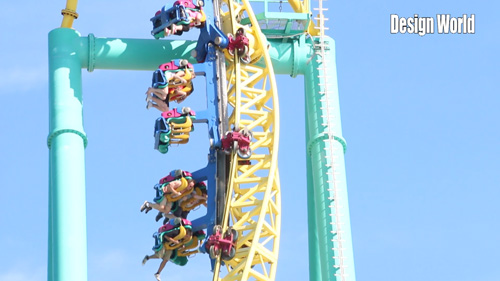 The Wicked Twister at Cedar Point in Sandusky, Ohio is a unique take on a roller coaster. Instead of carrying riders up a hill, the ride uses a horizontal launch to propel riders up and down two 450° spiral towers.
The Wicked Twister at Cedar Point in Sandusky, Ohio is a unique take on a roller coaster. Instead of carrying riders up a hill, the ride uses a horizontal launch to propel riders up and down two 450° spiral towers.
In the second installment in Design World’s Summer Tech Vacation video series, I spoke with Monty Jasper, Corporate Vice President for Safety & Engineering for Cedar Fair about the engineering behind the Wicked Twister, taking a look at the linear induction motors (LIMs) used to give the speed to the cars racing up the track.
Operation of LIMs is simple at first—take two magnets, run a piece of metal alloy (in this case, aluminum alloy fins) through that field, and watch the train move. Several series of these magnetic coils are run along the left and right side of the track, with a gap between them. Running the fin through that magnetic field makes the fin want to jump out of it, thus propelling the train as each set of LIMs are turned on in sequence. “In this particular ride, we do that in such way that you gain speed from 0-55 mph on the first pass and then we reverse it, coming backwards, so you can get up to 70 mph,” Jasper said.

Jasper said Cedar Point chose LIMs for Wicked Twister because horizontal launch options are limited and the electrical option is extremely innovative. However, the computer controls are complicated and must be programmed correctly or else the ride won’t operate correctly. “It takes a lot of expertise to maintain this ride,” Jasper said.
Similarly, across the park, Cedar Point’s Maverick roller coaster uses linear synchronous motors (LSMs). Unlike LIMs and their metal fin, LSMs take two magnets and run an always-energized earth magnet between them to propel the train forward.
While LIMs offer high speeds, LSMs offer better efficiency. With Maverick, speed is not the important thing. “It’s just stealthy quiet,” Jasper said. “It’s awe-inspiring to stand there in the Midway and not hear a noise, not hear any sound whatsoever as it’s going up the lift. It’s almost ghostly.”
Having hundreds of these magnetic fields spaced on the track allows Cedar Point to energize them as the train approaches and turn them off after it’s passed. This level of control allows the train to efficiently and quietly ascend the hill and coast down all the hills and turns.
And because of the earth magnets, Maverick has a built-in safety feature. “The neat thing about LSMs, is if you turn the power off, they act like a brake coming back down the lift, even if the power’s turned off,” Jasper said. “So you have this always-there emergency roll-back system that, in the event of a power failure, will always bring the train back down safely to the lift and stop it.”
One of the biggest advantages to using LIMs and LSMs is that maintenance is reduced. “You suddenly have no metal-to-metal contacts, no wear points, no rubber driving on it, no chain moving around, no lubrication, no worn out pieces and parts, because it’s all not touching,” Jasper said. “The only thing that’s touching are the wheels on the track.”
Watch our on-site interview to learn more about this unique technology. And stay tuned for all five videos in the Summer Tech Vacation series, with looks at the variable frequency drives on Gatekeeper, pneumatics on Power Tower, hydraulics on Top Thrill Dragster, and cable lift technology on Millennium Force.
Cedar Point
www.cedarpoint.com


What is the news? One my customer use linear motor for rollercoaster launch system and it starts many years ago… Tahabisha in Japan is one of the world famous rollercoaster with a launch system of my customer and he use our drives.